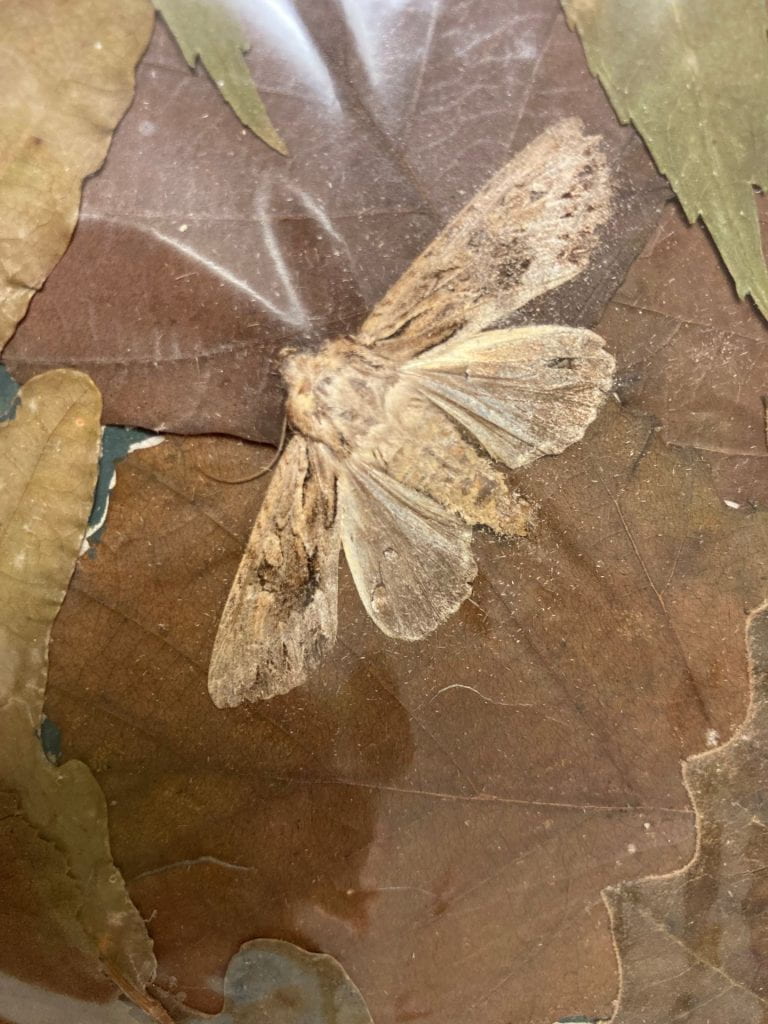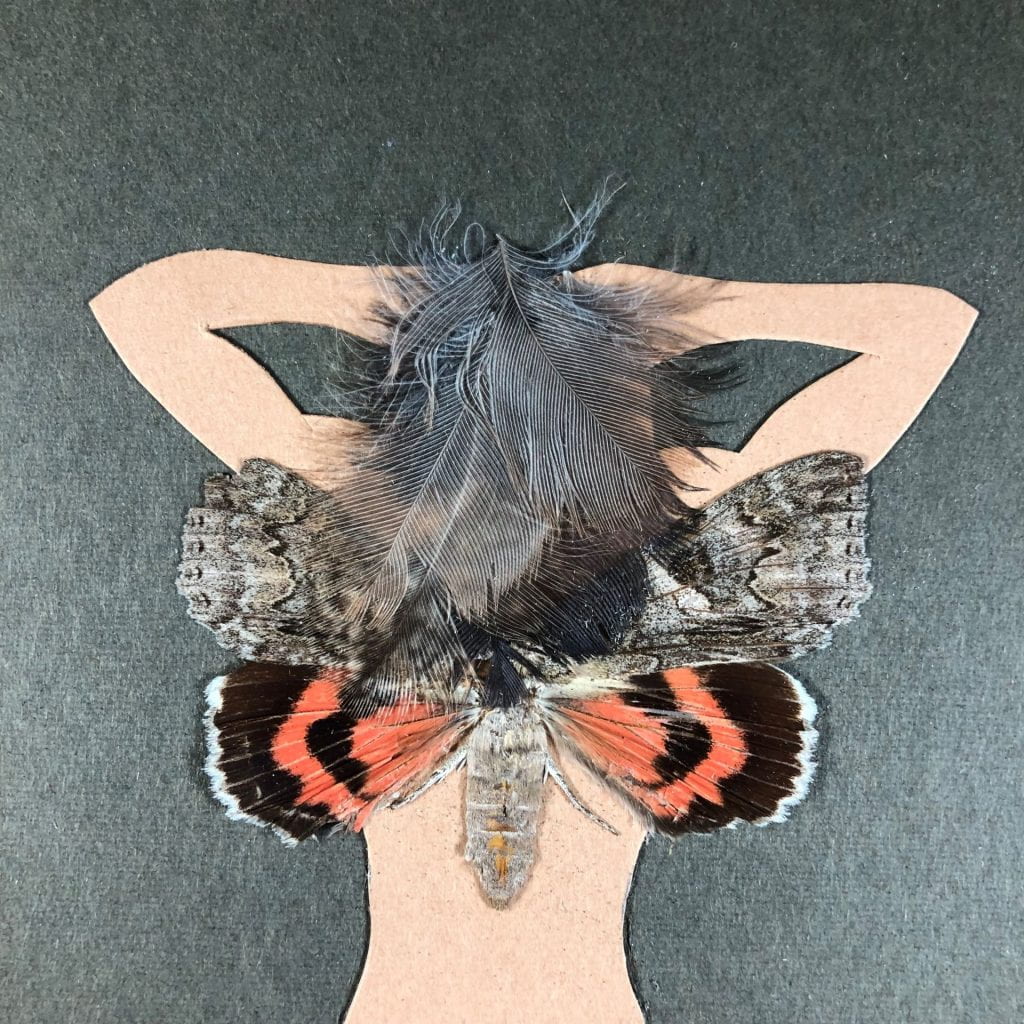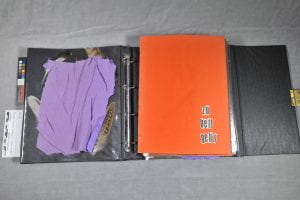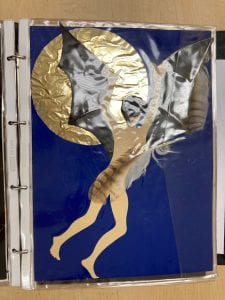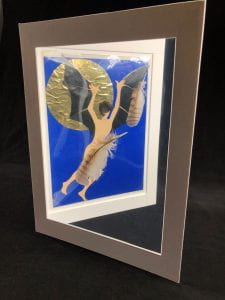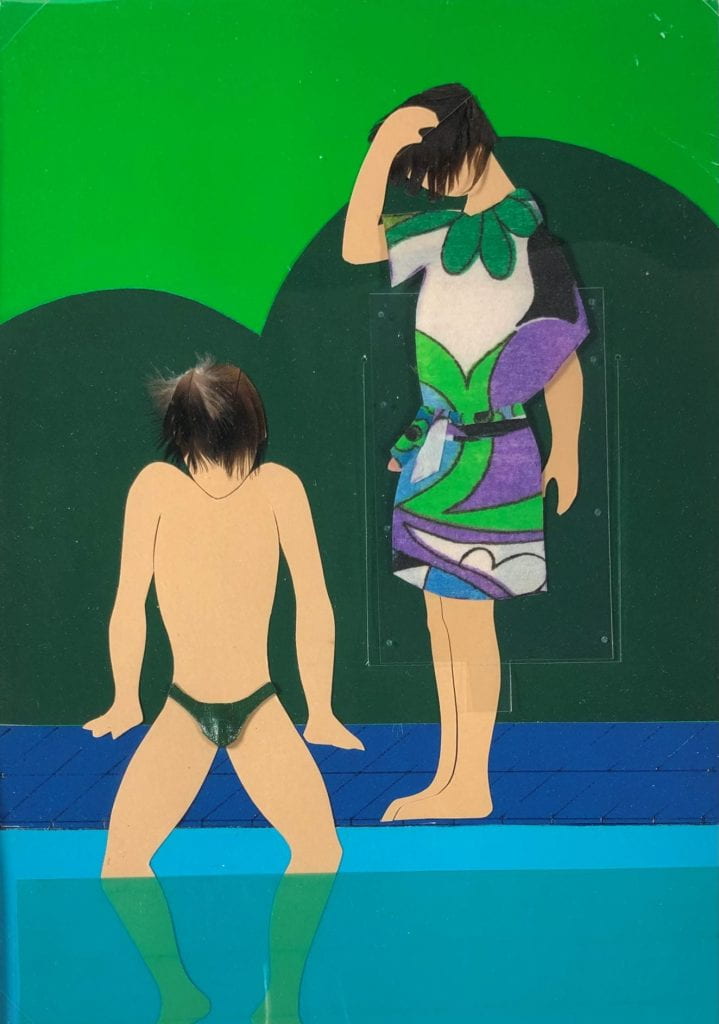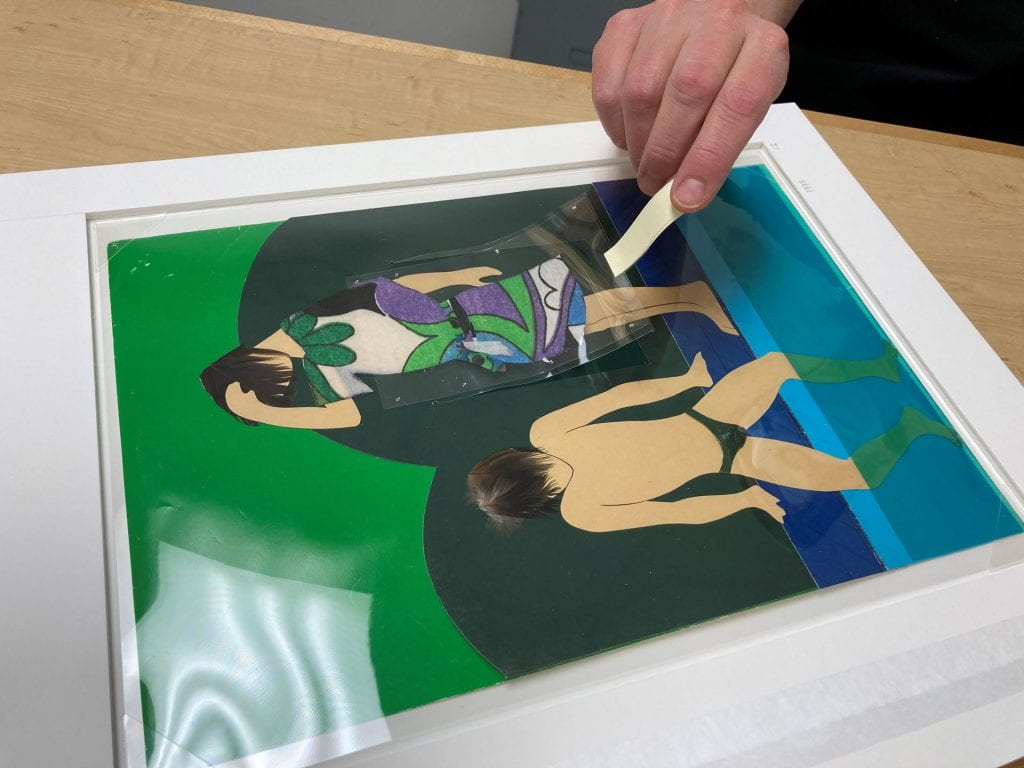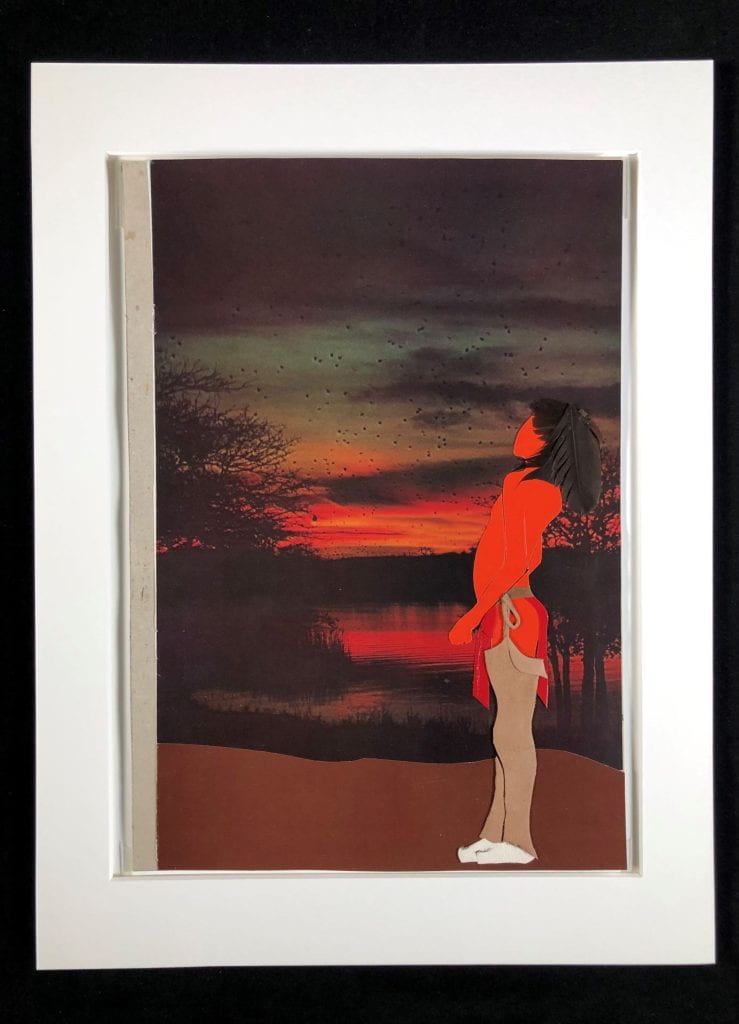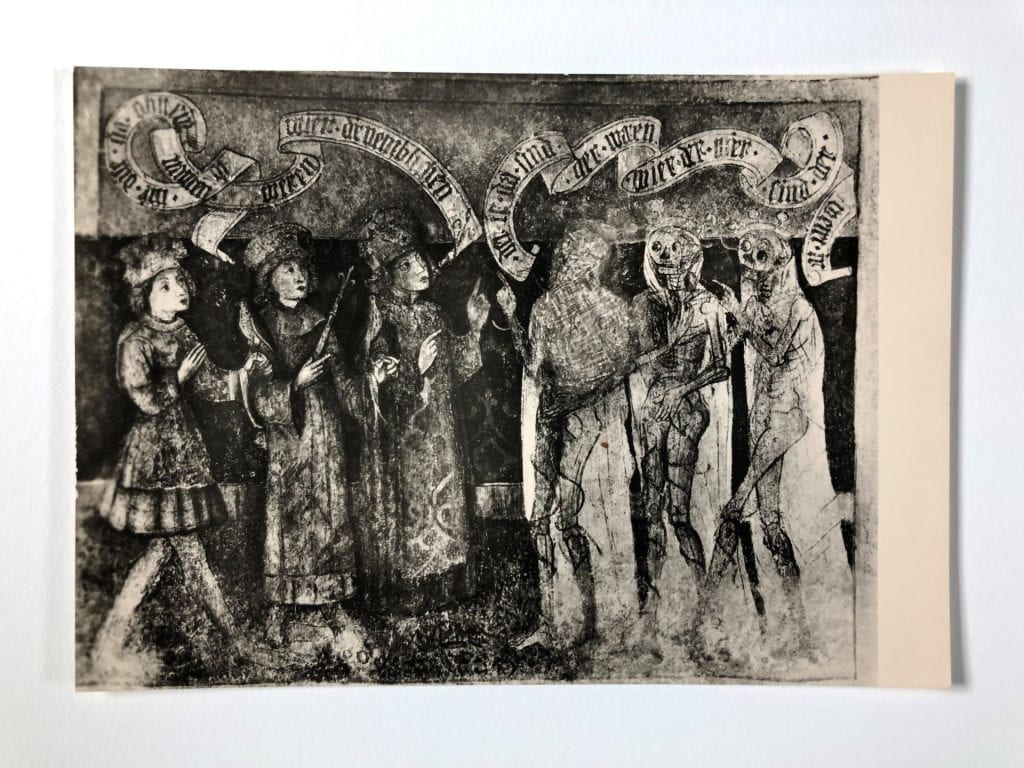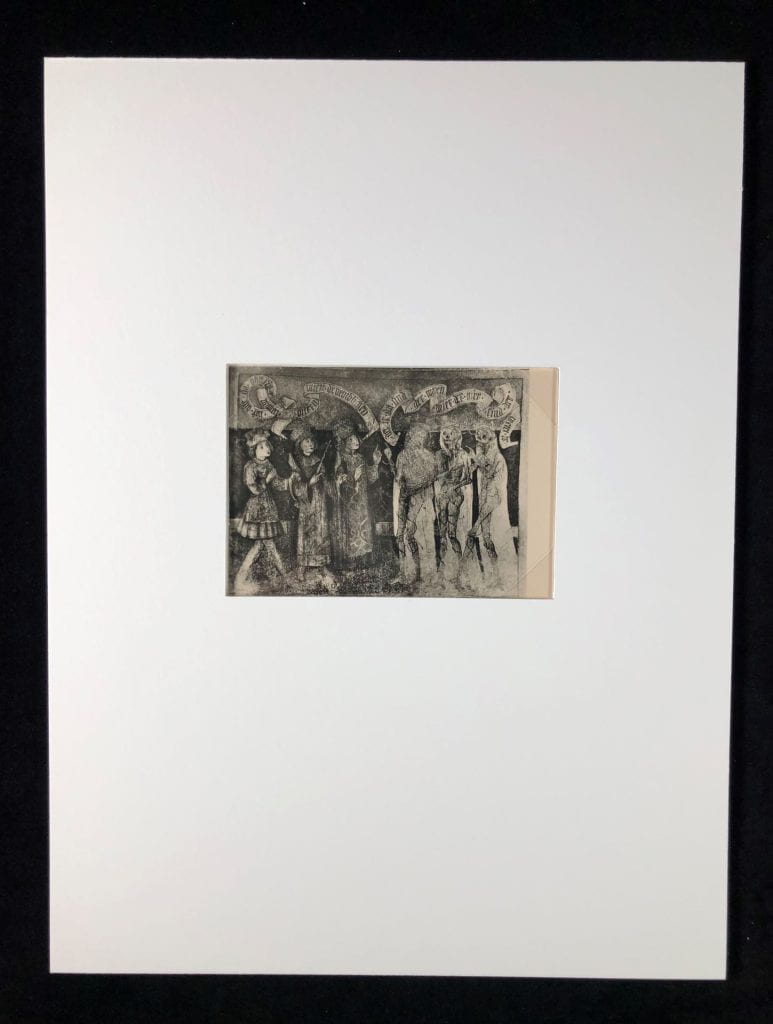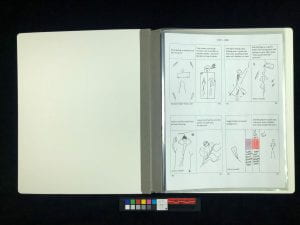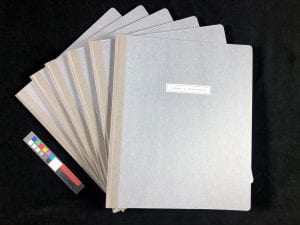By Laura Berenger
The collage artworks by Stjopka (born 1956) present a very detailed world and an imagination that is adventurous, historical, tender, macabre, and often erotic. Protecting both the physical materials and the dynamism of the artist’s narrative brought several unusual considerations to the fore for the conservation lab.

Binder as it was received in the lab.
Northwestern acquired six vinyl, faux leather three-ring binders of collages by Stjopka (a pseudonym), containing 290 works. These were brought to the conservation lab in the summer of 2021. Each binder contained an average of fifty collages measuring approximately 13 x 9.5 inches. The artist placed two collages back-to-back in each polyvinyl chloride (PVC) page protector. Materials forming the collages include various papers, leathers, fabrics, feathers, moths, dried flowers, dried leaves, jewelry, newspaper clippings, human hair, and adhered metals and plastics. The artist utilized the PVC sleeves to maintain the narrative order of the collages, protect collage components, and position un-adhered materials that could be moved to reveal hidden elements. Unfortunately, the PVC sleeves were yellowing, distorted, and becoming sticky as they degraded. Replacing them was necessary to stabilize the collages.
Problem solving
Several sink mat prototypes were made, and several conversations took place with Scott Krafft, Chief Curator of the Charles Deering McCormick Library of Special Collections, in an effort to design next best steps. No one wanted to intervene and undermine the artist’s original intent, but leaving the collages in the original PVC sleeves was untenable, and creating extra-deep sink mats with no protective layer for the delicate items on the collages did not provide adequate protection.

Collage with figure, dressed in leather, placed above plastic lips.
Each collage was removed from the original PVC sleeve and placed in a polyester film L-sleeve. A two-part sink mat was fabricated to hold each collage in its film sleeve. Two-ply matboard serves as the base onto which thicknesses of matboard trim are adhered. The front frame of the sink mat is hinged to the base with 1-inch Tyvek tape. The film sleeves are held in place with self-adhesive mounting corners.
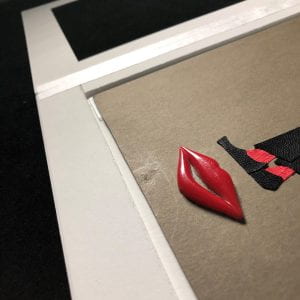
Raking light shows height of lips, depth of sink mat
The depth was customized to accommodate the thickness of inclusions on the collage. In some cases, only a single layer of 4-ply matboard was attached; in other cases, several layers of 8-ply were stacked to create enough depth to accommodate thick pieces of tree bark, plastic decorations, and seashells.
The thickness of the adhered plastic lips required a one-quarter inch accommodation in the sink mat.
Moth and Flora Consolidation
While removing collages, it was apparent that some of the many insect components, like moths, and some of the flower petals were friable and sticking to the PVC sleeves. This condition would only be exacerbated by the use of polyester film, so consolidation would be needed. I reached out to JP Brown, Regenstein Conservator for Pacific Anthropology at Chicago’s Field Museum, to ask if he had experience in consolidating fragile moths and dried flora. The scales and lumen on moth wings were especially likely to cling to polyester film, as they had to the polyvinyl chloride plastic. He suggested that I avoid water-based adhesive, and instead experiment with Paraloid B-72, Butvar B-98, and Klucel G in ethanol.
With JP Brown’s suggestions in mind, Chief Conservator at Northwestern University Libraries, Susan Russick, and I tested B-72, 0.5% Klucel-G in isopropanol, Aquazol in H2O 20%, and Aquazol in ethanol (approximately 10 % solution) on pastel chalks on paper. We applied each solution with two methods: a small brush, and by dripping a dot of solution onto the medium. The pastels migrated when solutions were applied with a brush. There was also some darkening of the color with the application of all of the solutions except Klucel-G.
After completing the pastel tests, Klucel-G and B-72 solutions were the clear winners. We collected moth wing samples from the local environment and continued testing. B-72 hardened in such a way that the moth wing “cracked” away from the spot of adhesion to paper. Klucel-G worked well as a consolidant and as an adhesive for both the fragile wings, moth body, and dried petals. We successfully experimented with putting a 1:1 solution of the 0.5% Klucel-G and isopropanol in a small atomizer. The resulting spray was fine enough to not damage the moth or petal, but applied a layer thick enough to consolidate. It required several pumps of the spray to use the mixture as an adhesive. The area around each consolidated moth or petal was masked during the spray application.
Reveal Components
Curtains
The artist included several fabric dividers, or “curtains” in each binder. The fabrics varied in weight and finish. The fabric dividers were not placed in PVC sleeves by the artist in the original binders, like the collages. As a result, we did not want the fabric dividers in sink mats. Instead, they were encapsulated in 5 mil polyester film with a label indicating their location between collage pages. This solution retains the original function of having loose fabric among the pages, clearly labels the location of the item, and allows the viewer to handle the item without touching the fabric.
Interactive features
In removing some of the collages from the original sleeves, it became evident that there existed an interactive component. An un-adhered item, such as a feather or a ticket stub, was strategically placed on the surface of the collage to conceal another facet of the collage. We referred to these interactive elements as “reveals.”
In addition to the use of polyester film L-sleeves, polyester film was used to retain the unusual kinetic feature of dozens of the collages. Any interactive item, such as a feather, was placed between polyester film sheets and secured in place with welded dots. This polyester film page was mounted to the verso of the sink mat frame with Tyvek tape. The frame could be turned like a book page to reveal items below. While feather reveals were the most common interactive component, there were also leaf, fabric, and paper reveals throughout the collection.
The most precise reveal to accommodate depicts two figures at a pool edge. The standing figure wears a fabric tunic that is adhered to the figure near the shoulders, but also lifts below the waist. A special polyester film pocket, including a lifting tab, was carefully fabricated and welded to the polyester film sleeve to allow the lifting of the tunic while maintaining protection for the collage. The pocket had to be situated over the figure in such a way as to be lifted to reveal the anatomy underneath, but also fixed at a certain point so as not to lift the pocket so far that it created stress on the fabric.
Hidden Text and Supporting Material
Many of the collages hid information, which would not be available to the researcher in the original binders. It is now made visible without the need to remove the collage from its sink mat. In two specific instances, the material that inspired the collage was previously sandwiched between two collages in a single sleeve. In the original PVC sleeve, no verso information was visible. In the new housing, the relevant inspiration is on display.
A postcard was found hidden in the original binder between two collages that faced one another. The collages mimic the figures and positioning of the postcard image. The housing now exposes the postcard for the viewer.
Finding Guide
A finding guide was created for each original binder to record the original sequence of collages. Captions and simplified line drawings were created for each collage. Each guide was bound and housed in the same box as the original binder. A library patron or researcher can do a preliminary search of themes, frequency of reveals, frequency of verso information, and frequency of curtain dividers throughout the collection without needing to sort through every box of collages.
Conclusion

The artist’s concluding collage
The Stjopka collage collection finishes with a depiction of a youth with outstretched arms looking at a plane in the sky pulling a banner that reads “The End”; after nearly 300 collages, the artist arrives at a destination, of sorts. He constructed emotional and intensely detailed collages, sourcing and selecting the right color or texture of fabric for a shirt collar, or the right shade and stripes of a feather to suggest the direction of hair on a youth’s head. It was my pleasure to problem-solve, innovate where necessary, and fabricate protective enclosures and useful finding guides for this compelling collection. Insuring that Stjopka’s works can be safely viewed and interactively revealed will, hopefully, be the start of a robust inquiry into the artist, his technique, and his vision.

